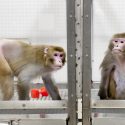Life history database aids wild primate studies
Karen Strier can breathe a sigh of relief, knowing that much of her life’s work is now safe.
The University of Wisconsin–Madison anthropologist has devoted the past 28 years to studying a wild population of northern muriqui monkeys in the Brazilian Atlantic Forest, compiling an unparalleled account of the births, deaths, and lives of hundreds of these critically endangered monkeys.
But the unexpected deaths of two friends and academic colleagues — one a UW–Madison professor, the other a Brazilian graduate student — in close succession highlighted the vulnerability of life and, potentially, one’s professional legacy.
“It occurred to me that parts of my research, especially these long-term data, were irreplaceable,” she says. “If I died, would someone else be able to extract and interpret all of the information from my computer?”
She also suspected she wasn’t alone. She approached a group of colleagues working on similar longitudinal primate studies to suggest compiling their field data in a single place. Their enthusiasm, along with support from the Wenner Gren Foundation for Anthropological Research, led to an initial workshop in 2005. Over the next few years, Strier and her co-principal investigator, Duke University professor Susan Alberts, laid the groundwork through a series of proposals and meetings.
Listen to the podcast of an interview with Karen Strier and Susan Alberts.
Five years later, the result is the Primate Life History Database, a collaborative and comprehensive database containing life history data collected from long-term field studies of seven species of lemurs, monkeys and apes.
In addition to preserving and standardizing data from seven of the longest-running field studies of their kind — ranging from 24 to 45 years in duration — the database will facilitate comparative analyses of primate evolution and ecology.
“The purpose of collecting data of this type is to make comparative analyses that can shed light on the population dynamics and the social and ecological adaptations that have shaped both human and nonhuman primate evolution,” according to a statement on the project’s website.
“We decided to build this database with the idea that we could answer questions with our comparative data that none of us could answer by ourselves,” says Strier.
The design and development of the database, undertaken in partnership with the National Evolutionary Synthesis Center (NESCent), is described in a paper published online Apr. 22 in the new journal Methods in Ecology and Evolution.
“It was a joint effort between people with very different perspectives ranging from primate biology to informatics to demography. We spent a lot of time working out a common vocabulary, and really produced an exciting resource as a result,” says Alberts, who is also the Associate Director for Science and Synthesis at NESCent.
The Primate Life History Database currently contains information about more than 3,300 individual monkeys and apes from researchers at UW–Madison, Duke University, Princeton University, the University of North Carolina-Charlotte, Iowa State University, Columbia University, the University of Calgary, the Dian Fossey Gorilla Fund International and the Atlanta Zoo, and the Institute of Primate Research at the National Museums of Kenya. The researchers are all members of the Primate Life History Database Working Group and co-authors of the new article.
Long-term life history data are extremely difficult to obtain but are incredibly valuable and can tell scientists a great deal about other primate species, including humans, Strier says. Current analyses are exploring mortality patterns and variations in fertility across multiple species, with implications for both conservation and human evolution.
Jointly funded by NESCent and the National Center for Ecological Analysis and Synthesis (NCEAS), the database provides a way to share and synthesize data with collaborators but in a way that does not relinquish ownership of the information, a key concern when sharing raw data.
“By putting this database together, we’ve shown that principal investigators of these long-term studies can collaborate and that these data now exist in a format that goes beyond each one of us, protecting the data for perpetuity,” Strier says. “It’s an amazing step forward.”




